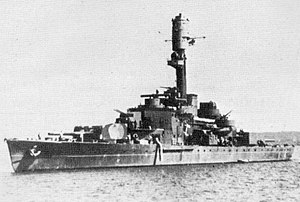
Back Pobřežní bitevní loď Czech Kystpanserskib Danish Küstenpanzerschiff German Buque de defensa costera Spanish کشتی دفاع ساحلی Persian Rannikkopanssarilaiva Finnish Navire de défense côtière French Kapal pertahanan pesisir ID Corazzata costiera Italian 海防戦艦 Japanese

Coastal defence ships (sometimes called coastal battleships or coast defence ships) were warships built for the purpose of coastal defence, mostly during the period from 1860 to 1920. They were small, often cruiser-sized warships that sacrificed speed and range for armour and armament. They were usually attractive to nations that either could not afford full-sized battleships or could be satisfied by specially designed shallow-draft vessels capable of littoral operations close to their own shores. The Nordic countries and Thailand found them particularly appropriate for their island-dotted coastal waters. Some vessels had limited blue-water capabilities; others operated in rivers.
The coastal defence ships differed from earlier monitors by having a higher freeboard and usually possessing both higher speed and a secondary armament; some examples also mounted casemated guns (monitors' guns were almost always in turrets). They varied in size from around 1,500 tons to 8,000 tons.
Their construction and appearance was often that of miniaturized pre-dreadnought battleships. As such, they carried heavier armour than cruisers or gunboats of equivalent size, were typically equipped with a main armament of two or four heavy and several lighter guns in turrets or casemates, and could steam at a higher speed than most monitors. In service they were mainly used as movable coastal artillery rather than instruments of sea control or fleet engagements like the battleships operated by blue-water navies. Few of these ships saw combat in the First World War, though some did in the Second World War. The last were scrapped in the 1970s.[note 1]
Navies with coastal defence ships serving as their main capital ships included those of Denmark, Ecuador, Finland, the Netherlands, Norway, Portugal, Sweden, Thailand, and the British colonies of India and Victoria. Some nations which at one time or another built, bought, or otherwise acquired their own front-line capital ships, such as Argentina, Austria-Hungary, Brazil, China, Germany, Russia, and Spain, also deployed this type of warship, with Russia using three at the Battle of Tsushima in 1905.
Apart from specially built coastal defence ships, some navies used various obsolescent ships in this role. The Royal Navy deployed four Majestic-class battleships as guardships in the Humber at the start of the First World War. Similarly, the U.S. Navy redesignated the Indiana and Iowa classes as "Coast Defense Battleships" in 1919. Such ships tended to be near the end of their service lives and while generally considered no longer fit for front-line service, they were still powerful enough for defensive duties in reserve situations.
Cite error: There are <ref group=note> tags on this page, but the references will not show without a {{reflist|group=note}} template (see the help page).